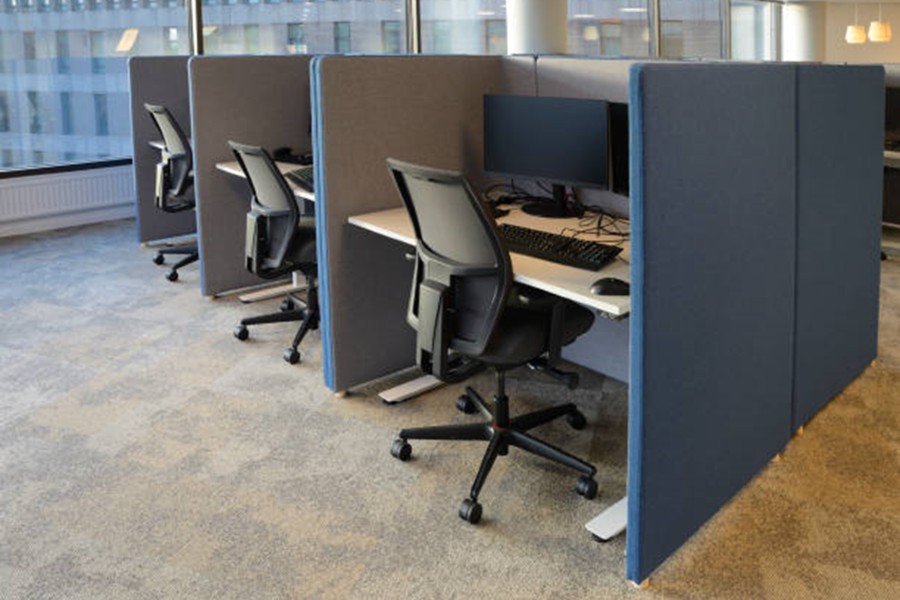
In the ever-evolving landscape of modern workplaces, the cubicle office has become a ubiquitous symbol of professional life.
Introduced as a response to the open-office concept’s drawbacks, cubicles were intended to strike a balance between collaboration and privacy. This article explores the evolution, advantages, and drawbacks of cubicle office, shedding light on their impact on employee productivity, well-being, and overall job satisfaction.
The Evolution of Cubicle Offices
The concept of the cubicle office originated in the 1960s when inventor Robert Propst introduced the “Action Office” system. Propst’s vision was to create a flexible, modular workspace that promoted both collaboration and individual focus. However, over time, the original idea underwent changes, and the cubicle office transformed into the standardized, grid-like structures we know today.
Advantages of Cubicle Offices
Privacy and Focus
One of the primary advantages of cubicles is the degree of privacy they provide. Employees can concentrate on their tasks without the constant visual and auditory distractions of an open-plan office. This setup fosters a conducive environment for deep work and focused productivity.
Customization and Personalization
Cubicles offer employees a personal space that can be customized to their liking. Decorative elements, family photos, and personalized items can make the workspace feel more comfortable and encourage a sense of ownership.
Cost-Effective Space Utilization
Cubicle offices make efficient use of space, allowing companies to accommodate more employees within a given floor area. This can be particularly beneficial for businesses operating in high-cost real estate markets.
Reduced Noise Levels
Unlike open-plan offices, cubicles help in reducing noise levels. The partitioning of individual workspaces acts as a buffer against the ambient noise that can be detrimental to concentration and overall productivity.
Drawbacks of Cubicle Offices:
Isolation and Lack of Collaboration
While cubicles provide privacy, they can also lead to isolation. Employees working in separate cubicles may find it challenging to collaborate spontaneously, hindering the flow of information and idea exchange within a team.
Monotony and Lack of Motivation
The repetitive nature of cubicle office can contribute to a monotonous work environment. The lack of visual stimulation and variation in surroundings may impact employee motivation and creativity negatively.
Limited Mobility and Flexibility
Cubicle setups are often criticized for their lack of mobility and adaptability. Employees may feel confined to their designated spaces, limiting their ability to move around and engage with colleagues in a more dynamic setting.
Potential for Clutter
Although customization is a benefit, it can also lead to cluttered workspaces. Excessive personalization might result in disorganized cubicles, affecting the overall aesthetic and potentially creating stress for employees.
The Impact on Employee Well-being:
Physical Health
The sedentary nature of cubicle work can contribute to health issues such as back pain and eye strain. Encouraging employees to take breaks and providing ergonomic furniture can mitigate these concerns.
Mental Health
Cubicle offices may contribute to feelings of isolation and, in some cases, lead to a sense of detachment from the broader organizational culture. Employers need to foster a supportive work environment and promote mental well-being through initiatives such as employee assistance programs.
Work-Life Balance
The delineation between work and personal life can become blurred in a modern cubicle office setting, as employees may find it challenging to detach from their workstations. Encouraging clear boundaries and offering flexible work arrangements can address this issue.
Conclusion
The cubicle office, with its mix of advantages and drawbacks, continues to be a prevalent workplace design. Striking the right balance between privacy and collaboration, customization and organization, is essential to harness the full potential of this setup. Employers must also be attuned to the impact on employee well-being, addressing concerns related to physical health, mental health, and work-life balance. As the workplace evolves, finding innovative ways to enhance the cubicle office experience will be crucial in fostering a productive and satisfying work environment for all.
- 10 Resolutions To Keep Your Finances On Track In 2025
- Governor Hochul Bolsters Subway Security With National Guard Deployment
- Book Launch; ‘Beyond Architecture: The NEW New York’ By Barbaralee Diamonstein-Spielvogel
- Sponsored Love: Daddy’s Greek Potato Pie, A Book About Healthy Eating By CC Minton
- The Wider Applications Of AI Image Generators In Everyday Lives
Become a Harlem Insider!
By submitting this form, you are consenting to receive marketing emails from: . You can revoke your consent to receive emails at any time by using the SafeUnsubscribe® link, found at the bottom of every email. Emails are serviced by Constant Contact









